

The Best Persuasive Essay Graphic Organizers for Students
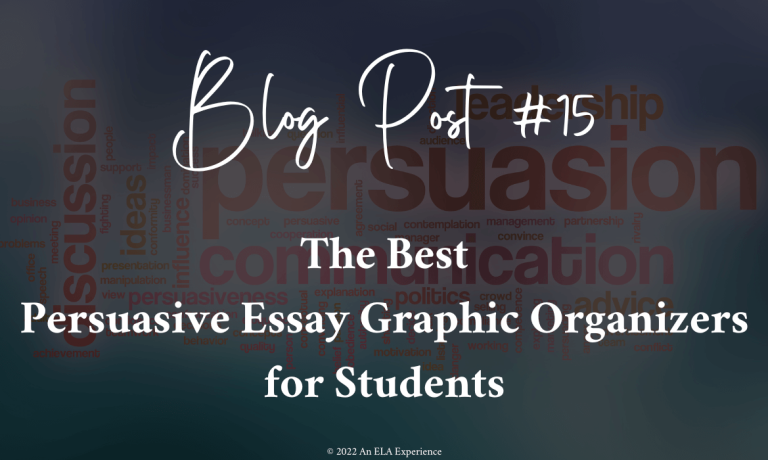
- December 11, 2022
You have just found the best persuasive essay graphic organizers! These organizers guide students through everything from choosing a topic to considering stakeholders to organizing the essay, and that’s not all!
Persuasive Essay Graphic Organizers for Finding a Topic
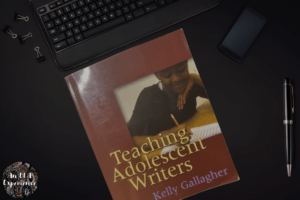
In Teaching Adolescent Writers , Kelly Gallagher states, “Choice generates a welcome chain reaction: it creates student buy-in, which in turn generates writing motivation, which in turn causes students to write better. Choice is where it starts for reluctant writers. . . .”
What a difference choice can make! We have a curriculum to follow, but we can spice up the entire writing process if we allow students choices. And what better way to begin than by permitting them to choose their topics for this essay?
Good and Bad Ideas
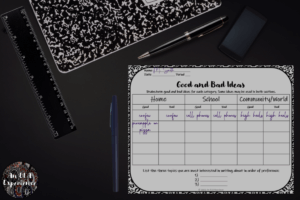
For this activity, students create a table with three headings: home , school , and community/world . Under each heading, they write good ideas and bad ideas . Next, they brainstorm ideas they think are worthy and unworthy under the appropriate section (e.g., curfews, cell phones in schools, high heels).
After they finish their brainstorming, they choose three ideas they are most interested in writing about and list them in order of preference. (I ask for three so students can change topics if theirs doesn’t lend itself to persuasive writing or if they’re later having trouble finding credible research, for example.)
Topics for Persuasive Essay
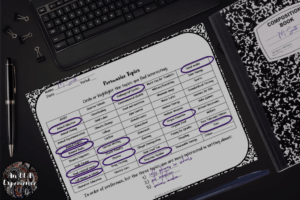
Another way to offer choice is to provide students with a list of topics. They circle or highlight the ones they find interesting and then choose the three they’re most interested in writing about. If they have a topic they feel strongly about that’s not on the list, then they can add it with your approval.
Persuasive Essay Graphic Organizer for Considering Stakeholders
Stakeholders’ viewpoints.
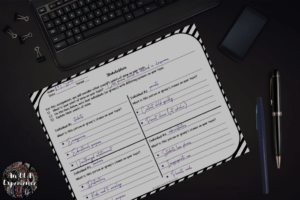
This activity is a shorter version of Gallagher’s “Four-Sided Argument.” (He teaches high school and has students write a page for each stakeholder; I work with middle school and have students bullet points for each stakeholder. Use what works best for your students.)
Considering the perspectives of people who may be affected by the topic allows students to see other points of view. Until researching, most teenagers won’t consider changing their viewpoints, but this lesson helps them ponder opposing arguments and prepare to write a more convincing essay.
To complete this activity, they create a table with four sections. In each section, they note an individual with a different opinion on the topic and note their points of view. (It’s important to choose people whose opinions differ.)
Persuasive Essay Graphic Organizers for Brainstorming Supporting Evidence and Opposing Viewpoints
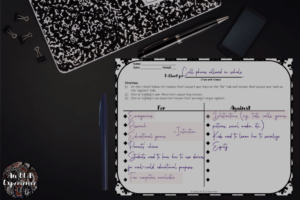
The t-chart is a super simple organizer, but it’s perfect for the persuasive essay. It can be created as soon as students decide on topics and added to as they research and consider other viewpoints.
Students use markers to draw lowercase t’s on their papers (large enough to take up a page in a composition book). They write their position at the top of the t , for on one side, and against on the other. They then list reasons that support their positions on the for side and reasons that oppose their positions on the against side. This activity ends with them selecting their three best supporting reasons and one important opposing reason.
Persuasive Essay Graphic Organizer for Researching
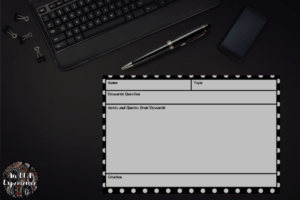
While creating example responses for this blog post and my products, I decided to write about allowing students to have cell phones in school. Honestly, I chose this topic because I already know about it through research and experience. Now, if I had class time to research as my students would, I might choose high heels for my topic. (They look great, but what are they doing to our feet?) I share this with you because most students will need time to research. They don’t have enough experience to just pull something out of a hat.
I find it helpful to provide them with notecards when they’re researching so they can remember what information was given, who said it, and where they found it.
They’re easy to create. Just insert a table into a Google or Word doc with the following headings:
- Research Question
- Notes and Quotes from Research
I also model this process for them with whatever topic I’m working on because they’ll need to know how to write good research questions (not a simple question for Alexa), find credible resources (e.g., databases or Google advanced search with .edu, .gov, or .org), and cite those sources correctly (using easybib.com , for example).
Persuasive Essay Graphic Organizers for Organizing
Bruffee’s organizational patterns.
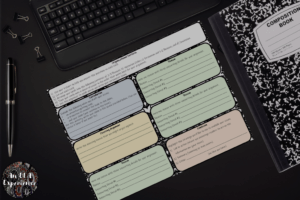
I learned about Bruffee’s Organizational Patterns from Joyce Armstrong Carroll and Edward E. Wilson’s Acts of Teaching: How to Teach Writing . What I love about it is that Bruffee gives writers different ways to organize essays so they’re not limited to a standard five-paragraph essay. Also, after manipulating the cards into the various patterns, students again have choice, for they choose the reasons they want to include and the pattern they think is most effective.
Preparing the Cards
For this activity, each student will need index cards with different colors:
- One blue index card for the introduction
- One orange index card for the conclusion
- One yellow index card for the opposing argument
- Three green index cards for the supporting reasons
(Use whatever cards you have, but make sure they include four different colors with the same color for the supporting reasons.)
After distributing the cards to students, demonstrate the following for students one step at a time as they imitate you.
Introduction Card
Title this card introduction , and write a few reminders (e.g., hook, transition, claim/thesis statement) and your claim on this card. Then have students do the same. (By this time, they have decided their positions on their topics, so they should have a claim, but it can be revised later if needed.)
Conclusion Card
Again, write conclusion and a few reminders for concluding a persuasive essay (e.g., summary and call to action) on this card.

Supporting Reason Cards
Title each of these cards reason and write one supporting reason on each card with three details for support. (They should refer to their t-charts for these.)
Opposing Argument Card
Title this card opposing argument and write the opposing reason that the writer might argue against.
Manipulating the Cards
Here’s the part where the magic happens. Again, walk students through each step, having them arrange the cards into the four patterns, noting that each card represents a paragraph and that the essay will always begin with the introduction and end with the conclusion.
Two Reasons
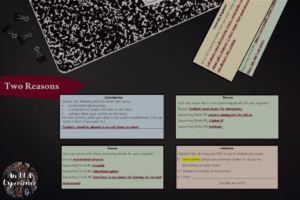
For this organizational pattern, you’ll use the cards that include the supporting reasons (not the opposing argument).
Arrange the cards in the order that you think works best for the essay (between the introduction and the conclusion). If you’re allowing students to turn in only one page of writing (because of state testing expectations, for example), then use only the two best reasons so that they’ll have space to fully develop these ideas. If you have two reasons that you think are fabulous and one that is mediocre, then consider omitting the third reason.
Nestorian Order
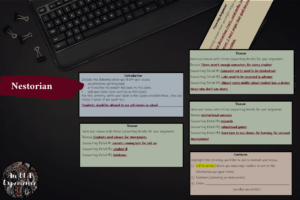
For this pattern, you’ll again use the cards that include the supporting reasons (and not the opposing argument), but this time, you’re going to put them in this order:
- Your next-to-best reason first (first body paragraph)
- Your least best reason second (second body paragraph)
- Your best reason third (third body paragraph)
As Dr. JAC says, you’ll start with a punch and end with a bang. I like this strategy because I’ve graded papers that have started out strong, on their way to an A, then ended weak, weak enough to lose that A. Hence, writers want to end as strongly as they begin.
Again, if you need to omit a paragraph, then set the least best reason aside.
Strawman and One Reason
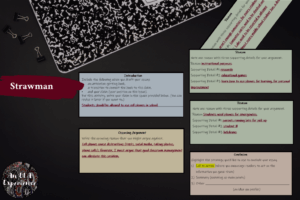
You’ll use this pattern if you have a valid counterargument you can refute.
I prefer knocking down the opposing argument immediately, in the first body paragraph, but I’ve seen writers do this in the last body paragraph too. Use whichever way works best for your essay. Then place the supporting cards one after the other, bringing in one to three of your supporting reasons. I like to bring in Nestorian Order here too (as long as it makes sense with the rest of the essay).
By the way, Texas teachers, this pattern will come in handy for the revised STAAR test. For grades eight and up on the argumentative essay of the 2022 STAAR, the argumentative rubric notes that counterarguments must be identified and refuted to score a three. (There are differences between a persuasive and argumentative essay, but both can refute an opposing argument.)
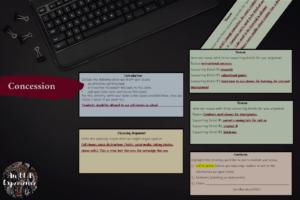
For this pattern, you’ll again need the card with the opposing argument along with the three supporting cards. However, instead of knocking down the argument, you’ll acknowledge it (e.g., yes, this is true, but. . . ).
As with Strawman, I prefer the concession to serve as my first body paragraph, but I’ve seen it as the last body paragraph too. Again, use what makes sense for your essay. Bring in the supporting cards, one after the other, omitting one or two reasons if needed.
Outline for a Persuasive Essay with Bruffee’s
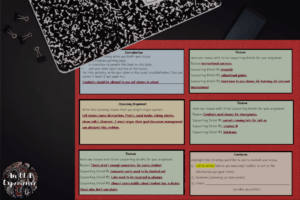
It’s time to bring this activity to an end. Decide which pattern works best, and tape your cards onto a sheet of computer paper in that order (introduction, body paragraphs, conclusion). You now have an outline to guide you as your draft your persuasive essay!
Templates for Persuasive Essays
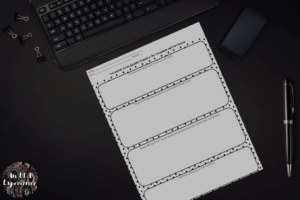
Use one to two-page PowerPoint or Google slides to create templates for each pattern with reminders. Just insert boxes and text, and change your slide size to 8 ½ by 11” portrait (in the U.S.). For the strawman pattern with one page, you can write the following reminders in each box:
- Introduction (with hook, transition, and claim)
- Important opposing argument you can refute (knock down)
- Reason #1 (your best reason developed with specific facts, details, and opinions)
- Conclusion (Summary or Call to Action)
Related Links
Persuasive Essay Graphic Organizers (TPT store)
Effective Persuasion Presentation – Purdue OWL® – Purdue University
Argumentative vs. Persuasive Writing (mass.edu)
How to Write a Persuasive Essay: Tips and Tricks | Grammarly
Graphic Organizers for Persuasive Writing in a Nutshell
- Create a good and bad idea graphic organizer to help you choose your topic.
- Brainstorm supporting evidence and opposing arguments on a t-chart.
- Consider stakeholders with a table with four boxes.
- Research on a note card.
- Add additional reasons (that both support and oppose your position) to your t-chart, and circle the three best supporting reasons and one valid opposing reason.
- Use Bruffee’s Organizational Patterns to determine the most effective way to organize your essay and to guide you as you write your essay.
Grab these persuasive essay graphic organizers at my TPT store or make them yourself, but make sure to use them!
Start teaching students how to use the comma with my free lessons, including anchor charts, warm-ups, and a slideshow with a corresponding booklet.
Enter your first name and email address, and I’ll send them to your inbox!
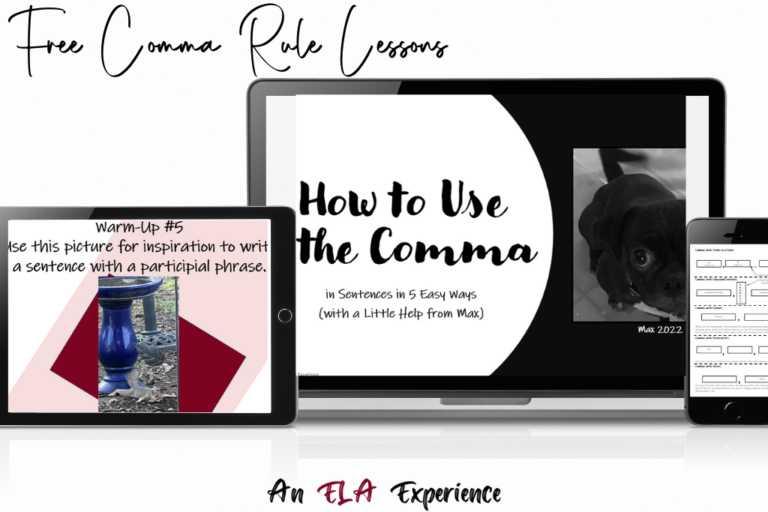
Leave a Reply Cancel reply
Your email address will not be published. Required fields are marked *
Save my name, email, and website in this browser for the next time I comment.

IMAGES